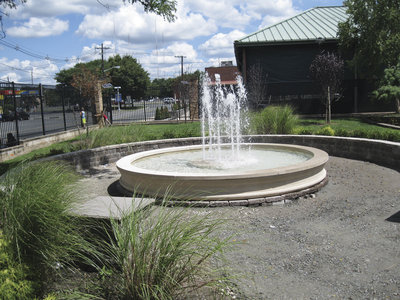Sometimes, all it takes to get things done in Secaucus is a little money.
“We’re constantly looking for new revenue sources so we can make improvements,” said Mayor Michael Gonnelli, talking about the reconstruction of Buchmuller Park over the last year, using a $1.6 million county Open Space grant.
“The entire park was rehabbed. We’ve added new synthetic turf on the Little League Field, new bocce ball courts, basketball courts, tennis courts, new pavers, a new children’s playground,” he said. “It’s gorgeous. Working with Tom DeGise and county freeholders, we were able to use open space money. Actually, we were able to reallocate old money from the early 2000s to do that.”
This includes a newly installed fountain at the entrance that is already up and running.
“The project is almost done,” he said. “We should be having a rededication of the park in October. It will be a big event.”
The park has also seen an upgrade to its lighting and new landscaping.
The Little League field was the largest element of the project, since it included installation of drainage, the collector pipe, and manholes. And during reconstruction, crews uncovered a number of obstacles such as large rocks, and pieces of the former Lincoln Tunnel.
Buchmuller Park – which is located in the Plaza section of town – was developed originally under Mayor James Moore, converting land that had served as a dump after the end of World War II. Named after Albert Buchmuller, the man who dedicated the land, the park became a symbol of a new Secaucus at a time when dumps and swamps gave way to a more modern town.
“We’re constantly looking for new revenue sources so we can make improvements.” — Mayor Michael Gonnelli
____________
The park was, according to local officials, the town’s first real investment in recreation. Until then, the town did not have more than a few ballfields and no general use park.
The project as proposed in 1962 included a Little League stadium, an ice rink, and other park amenities.
“Next year it is our goal to get the ice rink redone,” Gonnelli said.
Finding revenue for these projects is not always easy.
“Municipalities need to find a way to generate revenue,” Gonnelli said. “The only way you’re going to keep taxes stable, to do improvements – whether they be road improvements or park improvements. That’s one of the things we’ve been able to do. We’ve generated revenue from a parking tax. We’re generating revenue from the Malanka landfill. It was being filled for years and the prior guys never looked to charge them a tipping fee. Now we are. We’re generating revenue from the environmental impact of the dinosaur park. We’re generating revenue by bringing our construction fees back to where they should be – based on what a lot of other towns in the state are doing.”
Tax sharing cut helped a lot this year
The reduction of this year’s tax sharing fee to the New Jersey Meadowlands Commission went a long way to bolstering town revenues, Gonnelli said.
With the intervention of Gov. Christopher Christie, this year’s outlay into the tax sharing pool went from nearly $3 million to just under $600,000.
Under a formula established when the NJMC was set up in 1969, communities like Secaucus who were allowed to develop taxable property were required to share some of the tax revenues with other Meadowlands Communities that were restricted from development. Secaucus is the largest contributor because it saw a significant amount of development, while Kearny is the biggest receiver because it became the host of many regional trash dumps.
But Secaucus has always objected to the formula, saying it was an unfair burden on a community that was also saddled with providing services to residential and business development.
Christie this year gave a Secaucus a one-year reprieve from the full payment and thus gave the municipal budget a boost.
Councilman Robert Costantino said in fact Secaucus has overpaid by $74 and the state is reimbursing Secaucus in two $37 payments, one in August and another in November.
But the deal is one of the the reasons why Gonnelli endorsed Republican Christie’s reelection.
“I take some heat from some people for endorsing him, but let’s face it, he’s not going to lose and he’s helping us,” Gonnelli said. “I also endorsed Cory Booker [for U.S. Senate]. He can be a big help for the town of Secaucus. I met with Booker several times. The guy is brilliant. Was I angry with him for luring Panasonic away from here, sure, but I think the guy is right for New Jersey.”
These are people Secaucus will need in the future.
“You need to work with and endorse the people you know who will help your town,” Gonnelli said. “We have a serious issue with tax sharing and we need the help of the governor to help us solve it. The only way we’re going to solve it is by working with him. What is working against him going to get you? Without the governor signing off on it, it doesn’t happen. Two years ago, when we struck a deal on the tax sharing, Gov. Christie vetoed it. Now he’s agreed to help us find a permanent solution.”
Christie was hugely involved in helping Secaucus and the region during the aftermath of Hurricane Sandy, Gonnelli said, noting that he would sometimes get calls twice a day from the governor asking how the state could help.
At one point, Christie arranged for a conference call with all Hudson County mayors that included President Barack Obama.
Gonnelli said he always supported district legislators. He said State Senator Nicholas Sacco has helped Secaucus a lot, and Assemblyman Vincent Prieto has been instrumental in all of the things taking place in tax sharing and other issues.
Al Sullivan may be reached at asullivan@hudsonreporter.com.
